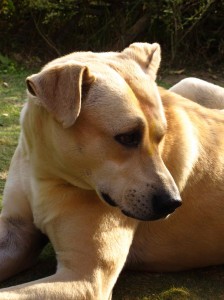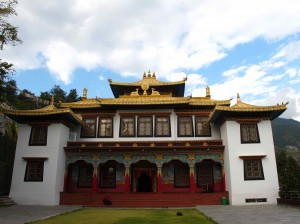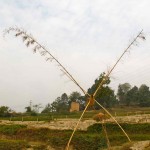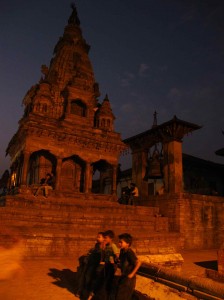Nepal is a country that we wished we had researched a lot more before we went – we were unprepared for many things. We had romantic, perhaps antiquated notions of Nepal when we planned our trip. While it was not what we expected, we learned a lot about what it means to be a good traveler in every sense of the word. However, simply saying “expect the unexpected” won’t get you through a dark alleyway after a meal of bland chicken soup, so here are O&A’s tips on visiting Nepal:

One of the two friendly dogs at Shivapuri. His partner, Indy the German Shepherd, loved playing fetch and would even run down the hill to find the rocks we flung.
1) We stayed at Shivapuri Heights Cottage (www.shivapuricottage.com) for two nights, which was perfect and we wish we’d been there straight from the airport rather than heading into the hot mess that is Kathmandu. Run by Steve Webster, an old Nepali Hand and his wife, Neeru, the property is perched on the outer edge of the Kathmandu Valley looking down into the city so you’re above the air pollution. You will be treated like family here and the travelers we met were all lovely – a young English couple beginning their ‘round the world honeymoon, international school teachers on reconnaissance for a school trip there later. Steve’s uncle started the legendary Tiger Tops, arguably the first company to make Nepal widely accessible as a tourism destination. If you’re looking for a safari or other

Our last breakfast at Shivapuri. We are situated outside the main house where we stayed; there is also a small cottage a bit down the hill from here where a young family from Dubai was staying while we were there.
adventuresome experiences, checking out their website is a good place to start – www.tigermountain.com.
2) One of the highlights of our time in Nepal was being in a small monastery during the afternoon prayers, which we never realized were basically the monk equivalent of homework. The monks filed in, many of the younger ones with one eye on the goofy foreigners in the corner, and then proceeded to recite mantras. Later in our trip, went to a much larger monastery, which felt a lot less authentic, even though they both seemed to be funded by deep pockets outside the country. Peering into the monks’ quarters in

A lone monk awaits the start of afternoon prayers on the steps to the monastery we hiked to from Shivapuri. It is less than five years old and was funded by a Buddhist organization in Taiwan.
the bigger one and seeing Playstations was disheartening, but I guess even monks get the yen for some GTA-style escape.

The site of the best meal we had in Nepal, a boarding house cum school. The chef is the woman in red below and she made us a satisfying, simple meal of lentils, rice, red beans, fingerling potatoes and kale on a sterno stove perched on a pile of coal in the corner of a room. Wonders never cease.
3) Trekking – make sure the trek you choose is right for you and talk to the company on the phone or even better, in person, before you go. The company we went with was recommended by Lonely Planet and sent us on a three day trek with two employees that looked very young and were green to the fact that it is a good idea to tell your clients what they will be doing and what to expect rather than walking in complete silence for days. Of course we asked questions about the things we saw or

A rural swing we saw on our trek. We passed by a few of these, none of them with actual swings set up. Chris noted that swing time must be tightly regulated in Nepal.
when lunch would be, but in a country where I’d say that the staring problems that foreign women can get is on the severe end, it is a lot more reassuring to know that the people guiding you state upfront that they know what they are doing and can therefore take care of you. We later expressed our opinions to the trekking company and to their credit, they gave us a partial refund and were grateful for our constructive feedback. This led me to really value countries with strong tourism organizations who make their presence known by accrediting guides and companies or putting their seals of approval on lodging and eateries that meet their standards. This is something that is lacking in Nepal, oddly, where tourism is a key industry.

It was mostly hazy on our trek, unfortunately, so I had to make do with some tightly cropped shots. If the sun does peek out and the sky turns blue, though, be sure to take a ton of photos!
4) Be prepared for a significantly less varied diet in the country than whatever you may have experienced at a Nepali restaurant overseas. Certainly this is true of many countries – you won’t find any self-respecting restaurants in
Japan that serve yakitori, sushi and shabu-shabu – but it is especially stark in a country that is agriculturally isolated from its neighbors and even the more fertile regions within its borders. So BYO pepper grinder, furikake, favorite Boite a Espice blend!
5) “Nepal is like India Lite,” said our friend Erica upon our return. We begged to differ. It’s India Dark. At night, always have a headlamp or flashlight – electricity is rationed and you will see very few lights on after sunset, even in Kathmandu. It is no exaggeration to say that some alleys are pitch black and you can easily get lost if you don’t know where

They look sweet and innocent but they are not - these little rascals descended on us in a manner that suggested petty thievery, so I quickly whipped out my camera and took a picture of them, which made them sit angelically.
you’re going or bring your own light source.
6) Make sure you know the value of taxi rides before you get into one. We always asked the concierge of our guesthouses about how much rides would cost. Taxi drivers also try to become your chauffeurs for the day. As we were only using taxis in Kathmandu, Bhaktapur and Patan, we easily found taxis in each location to take us where we wanted to go so there is no need to have a driver wait for you unless you are going to more remote areas.
7) We found the level of English fluency to be higher in Nepal than in India. Oftentimes in India, people would say they didn’t know what we were asking, but it was clear that they didn’t comprehend what we were saying. In Nepal, most people seemed to understand what we wanted and

The displays of wildflowers you will see in Nepal if you go during the right season are beautiful. We have read that rhododendrons such as these can grow up to 20 feet high!
were able to give us useful information or directions to someone who might know. Whenever we found someone who seemed exceptionally knowledgeable, we asked a few more questions on other topics that helped us become more comfortable with the country as a whole.
8) We didn’t fly anywhere within Nepal as it was high season so spots book up quickly and the weather can be iffy in any case. If you are flying anywhere, be sure you have at least a day’s cushion on either end, or at least travel insurance, as dangerous flying conditions in the Himalayas caused some internal flights to be canceled for three days straight while we were there.

